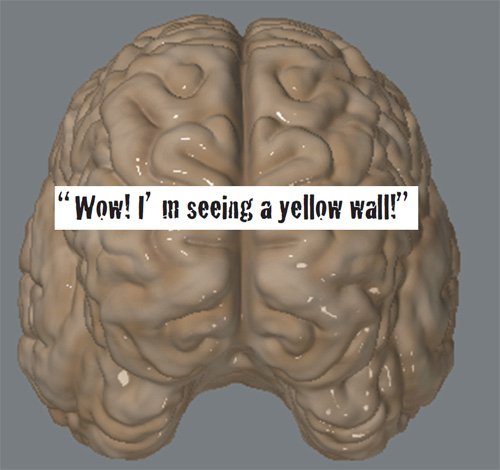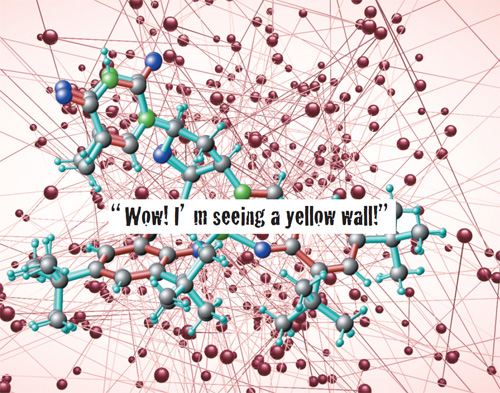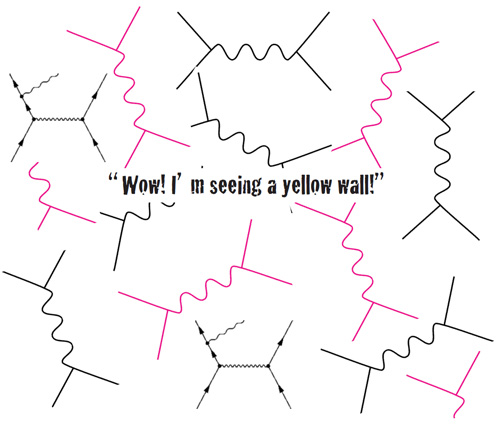
Your complimentary articles
You’ve read one of your four complimentary articles for this month.
You can read four articles free per month. To have complete access to the thousands of philosophy articles on this site, please
Articles
On ‘Known-To-Be-False’ Materialist Philosophies of Mind
Graham Smetham argues that since quantum mechanics tells us that matter is dependent on the observer, the mind can’t be reduced to the brain.
On the 4th of July, the European Center for Nuclear Research (CERN) announced that the two largest experiments at the Large Hadron Collider had uncovered evidence for the Higgs boson. This ‘particle’, called by some the ‘God particle’, and the Higgs quantum field that causes it, have been hypothesized as being necessary to explain how mass comes into being. As the science writer Jim Baggott says in his recent book Higgs: The Invention and Discovery of the ‘God Particle’: “Mass is constructed entirely from the energy of interactions involving naturally massless elementary particles… The physicists kept dividing, and in the end found nothing at all.” Mass, and so matter, are derived aspects of an insubstantial process of reality. In fact, they’re also products of aspects of reality that are immaterial, ie not material at all.
However, this conclusion should not come as a shock, for if there is one thing that has been established by the science of quantum mechanics, it is the fact that ‘materialism’ must be abandoned as a viable metaphysical position. In fact, the belief in the existence of solid material stuff which exists completely independent of mind is now about as scientifically acceptable as the phlogiston theory of heat. This is why physicist John Gribben has written a book entitled The End of the Matter Myth; not to forget pronouncements such as that made in 1931 by the instigator of quantum theory, Max Planck, that he regarded “consciousness as fundamental, I regard matter as derivative from consciousness,” or that by Erwin Schrödinger, “Mind has erected the objective outside world … out of its own stuff” (What is Life? 1944). Regarding the metaphysical implications of the quantum revolution, quantum physicist Professor Henry Stapp of Lawrence Berkeley National Laboratory, University of California, says in his article ‘Why Classical Mechanics Cannot Naturally Accommodate Consciousness But Quantum Mechanics Can’: “the ‘matter’ that occurs in classical physics … does not exist in nature.” As we shall see, there is absolutely no ‘material stuff’ to be found anywhere in the fundamental grounds of the Universe – that is, as ‘material stuff’ has been classically (mis)understood.
Mind Matters
Before we look at the reasons why such a conclusion is inevitable, it will be informative to briefly survey what a few other significant physicists have to say on the matter of the ultimate lack of matter. Of the quantum dissolution of the ‘purely’ material world Sir Roger Penrose, a professor of physics at Oxford University writes, “it is particularly difficult to make sense of the kind of ‘physical reality’ – or lack of it – that it [QM] seems to imply for our world.” (Shadows of the Mind, 1995, p.237.)
Anyone who reads Penrose’s books on the subject cannot fail to conclude that quantum physics removes the primacy of the ‘purely material’ from the ultimate realm of reality, whilst keeping consciousness in some form centre stage. For instance, in The Road to Reality (2004), he writes, “almost all the ‘conventional’ interpretations of quantum mechanics ultimately depend upon the presence of a ‘perceiving being’.” (p.1031). And “As far as I can make out, the only interpretations that do not necessarily depend upon some notion of ‘conscious observer’… require some fundamental change in the rules of quantum mechanics” (p.1032).
Penrose makes several remarks indicating that perception/consciousness is fundamentally entangled with quantum reality. Furthermore, Penrose has apparently always hated this conclusion. However, he was forced by the evidence to conclude that in the quantum realm, “the place where ‘the buck stops’ is provided by our conscious perceptions.” (Shadows of the Mind, 1995, p.309). In a sense, one might say Penrose’s work has been a desperate but failed effort to avoid this conclusion.
Quantum physicist David Bohm also clearly emphasises the absence of ‘classical’ matter at the quantum level: “variables [ie the idea of continuous properties] can no longer provide us with a definite, unique and unambiguous concept of matter in the quantum domain. Only in the classical domain is such a concept an adequate approximation.” (Wholeness and the Implicate Order, 1980, p.95) And another physicist Robert Oerter, in his book The Theory of Almost Everything (2006), writes, “The laws of physics were saying that matter as we know it simply can’t exist” (p.59.) Professor Anton Zeilinger and his team carried out incredibly precise and subtle experiments at the limits of physical possibility. In his contribution to the collection of cutting-edge quantum physics essays Science and Ultimate Reality (2004), he concludes that the pre-quantum or classical view of the material world involves “the obviously wrong notion of a reality independent of us.” (p.201). In Quantum Reality: Theory and Philosophy (2009), Jonathan Allday also tells us that within Quantum Field Theory, which deals with the most fundamental levels of physical reality, there is no mind-independent material substance: “Our whole manner of speech… rather naturally makes us think that there is some stuff or substance on which properties can, in a sense, be glued… Philosophers have been debating the correctness of such arguments for a long time. Now, it seems, experimental science has come along and shown that, at least at the quantum level, the objects we study have no substance to them independent of their [perceived] properties.” (p.493.) Many more quotes of this nature could be assembled from the writing of modern physicists, whilst virtually none asserting the opposing view may be found.
Henry Stapp has also consistently pointed out the deeply erroneous and flawed nature of simplistic materialist viewpoints when considered from the perspective of quantum physics. Indeed, he is quite scathing about many philosophers of mind:
“Philosophers of mind appear to have arrived today at less-than-satisfactory solutions to the mind-brain and free will problems, and the difficulties seem, at least prima facie, very closely connected with their acceptance of a known-to-be-false understanding of the nature of the physical world, and of the causal role of our conscious thoughts within it.”
‘Philosophy of Mind and the Problem of Free Will in the Light of Quantum Mechanics’
The most interesting phrase here is ‘known-to-be-false’. The astonishing fact is that the academic philosophy community has allowed a large number of its members, especially philosophers of mind or science, to flagrantly ignore or misrepresent contemporary physics in order to defend obviously incorrect ‘classical’ pre-quantum positions redolent of the worldview of the late nineteenth century. As Stapp has pointed out:
“the re-bonding [of mind and matter in QM] achieved by physicists during the first half of the twentieth century must be seen as a momentous development: a lifting of the veil. Ignoring this huge and enormously pertinent development in basic science, and proclaiming the validity of materialism on the basis of an inapplicable-in-this-context nineteenth century science, is an irrational act.”
‘Quantum Interactive Dualism’ p.18
The evidence from quantum mechanics for this is now overwhelming. Despite this, hard-headed (a fitting epithet) materialists are regularly allowed the public arena to proclaim their unscientific views in the name of philosophy or science, and in so doing they grievously mislead the public.
What Does Quantum Mechanics Say?
According to Stapp, the evidence of quantum theory “upsets the whole apple cart. It produced a seismic shift in our ideas about both the nature of reality, and the nature of our relationship to the reality that envelops and sustains us… The effect of this change is profound: it replaces the world of material substances by a world populated by actions, and by potentialities for the occurrence of the various possible observed feedbacks from these actions.” (Mindful Universe, 2007, p.20.) Thus, according to Stapp, what brings physical reality out of its potential state into a determinate actuality, is mental interaction with the quantum potentiality of the universe. In other words, quantum-scale ‘objects’ only come into full existence when they are observed. As physicists Bruce Rosenblum and Fred Kuttner bluntly say concerning this, “The object was not there before you found it there. Your happening to find it there caused it to be there.” (Quantum Enigma: Science Encounters Consciousness, 2006, p.75.) This way of putting it is somewhat heavy-handed, but as the authors are keen to emphasise, the essential point is that at the quantum level there is no classical materiality. Rather, what exists is the potentiality for experiences of material properties, and matter as it is being experienced. Thus the realm of ultimate material reality for quantum theory – the ‘quantum ground’, as I’ll call it – is somewhat immaterial: it has a ghostly kind of existence which provides the possibility of the experience of material reality (and experiences only manifest when consciousness gets involved in some way). Because experiences apparently produce or manifest the material world at the quantum level, one implication seems to be that the entire material world, or at least the appearance of the material world, is in some way dependent upon consciousness.
David Bohm called the quantum ground of the physical world ‘the implicate order’. This ‘implicate’ order manifests as the ‘explicate’ order of individuated consciousness, and the material world as we experience it. The crucial point here is that, although at the level of our everyday world there strongly and ineluctably appears that there is an independent, self-contained world of materiality, quantum physics has incontrovertibly shown that ultimately speaking, this is not the case, and matter needs mind to determinately exist.
For a long time quantum theory has been considered to be a great mystery. Today an even greater mystery is why Daniel Dennett, or Paul and Patricia Churchland, or many others, are allowed to teach “known-to-be-false” views of the material world, and so the brain, at colleges and universities.
What Is Materialism?
Quantum theory demolishes the materialist viewpoint. But to understand why, we must be clear what ‘materialism’ is.
The canonical materialist view, which derives from categories of substance established by René Descartes in the seventeenth century, says that there exists a realm of ‘stuff’ which has no mental qualities and which exists independently of mind, and that this is the material world. Furthermore, the materialist viewpoint asserts that, in some mysterious way, this mindless material stuff somehow manages to produce minds: yet the material stuff is still somehow the only stuff that exists. A striking statement of this view is given by Daniel Dennett: “An impersonal, unreflective, robotic, mindless little scrap of molecular machinery is the ultimate basis of all the agency, and hence meaning, and hence consciousness, in the universe.” (Darwin’s Dangerous Idea, 1996, p.27). However, such a view is easily shown to be false, precisely because at the quantum level there is no ‘molecular machinery’: there is a quantum field of material potentiality which also has a potential for an experiencing mind. The ‘molecular machinery’ emerges a bit further up the scale of manifestation from the quantum ground, and so it is certainly not the ultimate basis of anything.
Materialism is currently a popular school in the philosophy of mind. Now if for the sake of argument we accept from the overwhelming evidence that the experience of seeing a yellow wall (say) is generated through some kind of neuronal activity in the brain (perhaps in the ‘V4 region’ at the back of the brain), then it follows that the matter of the brain is the kind of stuff which in certain configurations can produce experiences. We might say at least that the brain must be composed of stuff that has the potential to create experience in the right circumstances. This might mean that one has already redefined ‘matter’ as ‘stuff which has the capacity to produce mind’. However, this is not the kind of matter so beloved by staunch materialists, who like their matter neat, so to speak, with no added mind.
At the quantum level of analysis, the brain is made up of 99.999 etc% empty space, plus a system of molecules, atoms and so on. But these atomic constituents, as Stapp points out, do not exist as independent self-contained material entities. Ultimately they emerge out of the quantum field of potentiality; and their emergence in some way depends upon consciousness. When we know all this (and all this is known), then the materialists’ picture of mind-independent jiggling molecules in a materially substantial brain dissolves. As Stapp says, “no such brain exists; no brain, body, or anything else in the real world is composed of those tiny bits of matter that Newton imagined the universe to be made of” (Mindful Universe, 2007, p.139). Rather, the physical grounds in the brain of the experience of the seeing of a yellow wall reduces to a jiggling of an insubstantial quantum field, as the illustration illustrates.
Fig 1: Scales of physical existence in the brain:

Level 1: Everyday scale, whole brain, mushy, but generally solid, determinate

Level 2: Molecular scale, still apparently solid

Level 3: Subatomic scale, quanta determinate only via minds
Although experiences and thought-processes are certainly dependent upon the higher level properties of the quantum field as it becomes organised into more-familiar material structures, the potential stuff of the quantum grounds must be the ultimate source of both the material structures of the world and of the experiences of sentient beings within it. In the most up-to-date understanding of quantum theory, it is quite clear that all apparently material structures and processes, including the brain, are emergent from insubstantial quantum ‘dream stuff’, to use a description by physicist Wojciech Zurek. In other words, acts of perception create material reality from the ground quantum ‘dream’ stuff. So Zurek reiterates Stapp’s point that acts of consciousness produce reality from quantum potentiality. So quantum theory clearly tells us that even the existence of a brain is a result of mental acts upon a deep quantum ground of potentiality. This means that the material of the brain is ultimately immaterial.
Conclusions
In the Guardian obituary for the great American physicist John Wheeler on 16 April 2008, we read that, “In 2002, he wrote: ‘How come the universe? How come us? How come anything?’… Wheeler’s answer to his ‘how come?’ questions was ‘that’s us’.” (Michael Carlson). Wheeler was one of a great many physicists who have been forced by the quantum evidence to accept that consciousness is primary, and that determinate matter is in a specific sense created by the functioning of mind in the quantum realm. Consciousness, then, must be an essential quality of the quantum field, at least potentially. Such a conclusion has inescapable implications when we consider the situation of a brain observing, say, a yellow wall. We may want to say that it is the jiggling of molecules and atoms that produce our experiences and thoughts; but if we take science seriously, we are forced to say that from a (more) ultimate point of view, probabilistic vibrations within the potential quantum field are the ultimate source, and these vibrations are made into determinate matter through perception of them.
Stapp has gone so far as to suggest that because the ultimate nature of quantum reality can only be mind-like, quantum theory hints at a God: “This [quantum] situation is concordant with the idea of a powerful God that creates the universe and its laws to get things started, but then bequeaths part of this power to beings created in his own image.” (‘Minds and Values in the Quantum Universe’ in Information and the Nature of Reality, Davies, Paul, and Gregersen, Niels Henrik (eds), 2010, p.117.) Such a view is by no means accepted by all physicists. But what is generally accepted is that a crude, simplistic materialism was shown by physicists to be untenable years ago. Possibly the most widely-accepted account of the ultimate nature of reality among the physicists, is that it consists of some kind of ‘informational’ quantum field which gives rise to both the manifest material world and experiences of it. But a quantum informational field is clearly not substantial or material, unless one redefines ‘substantial’ or ‘material’ to mean virtually the opposite of what these terms have traditionally meant.
© Graham Smetham 2012
Graham Smetham is a Buddhist philosopher whose latest book is Quantum Buddhism and the Higgs Discovery: The Power of Emptiness. Visit ShunyataPress.com or QuantumBuddhism.com.









